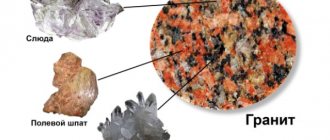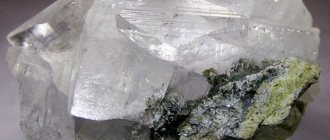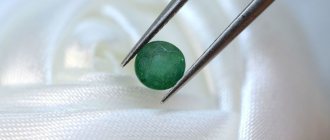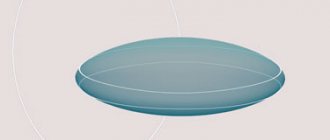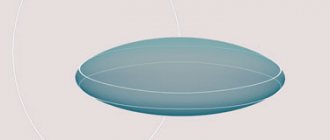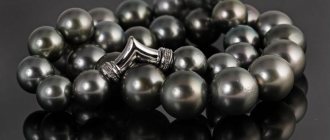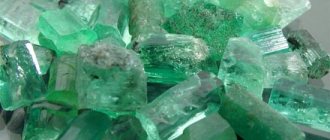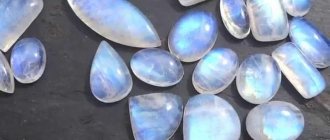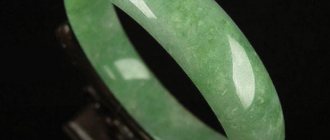Methods for measuring hardness
The degree of strength of a material is assessed by pressing a stronger object into it, as well as grinding and scratching its surface. The choice of which scale to measure the hardness of minerals is large. Besides leaving a groove with Mohs reference crystals, there are 6 main measurement methods:
- Rockwell scale - the depth of penetration of an identifier with a diamond tip into the material is recorded. Applicable to metals and alloys.
- Shore hardness is determined in the same way. Additionally, the method allows you to study the strength of plastic and elastic objects.
- The Knoop scale works on the principle of indentation. The result is assessed in Knoop units: diamond – 8500, corundum – 2000.
- Rock hardness using the Schreiner method is quantitatively determined by the ratio of the load on the punch to the die area. The measurement is accompanied by drawing a deformation diagram.
- The Rozival scale is based on the example of the Mohs table: indicators for a number of minerals were obtained using a hardness tester based on the results of grinding samples. The complexity of the method did not allow it to displace the classics.
- A Vickers pyramid reinforced with diamonds is statically pressed into the test object, and the result is viewed from the area of the indentation through a microscope. The devices are called hardness testers (for example, PMT-3).
All accurate methods for finding strength are inferior to the quick tabular method of determining by comparing the strength properties of minerals. It is not always necessary to see the breaking load; in most cases, it is enough to know which stone is harder.
Hardness standards for drinking water
SanPiN indicates variable values, depending on the use of aqueous solutions. Water hardness according to GOST is also regulated depending on the type and purpose of liquids:
- For ordinary mains water, the concentration of magnesium is determined (up to 50 mg/l).
- In bottled, the indicators Ca = 25-130 and Mg = 5-65 mg/l are taken into account.
- For water used for domestic and drinking purposes, the maximum permissible concentration for drinking water hardness should not exceed 350 mg/l (7-10 mg-eq/l or 1-1.5 grams per liter).
- For drinks of the highest category, the norm is Jo = 1.5-7, for the first category no more than 7 mEq/l.
- According to WHO standards, drinking water contains 10-30 mg of magnesium and 20-80 mg of calcium per liter.
- The total hardness for drinking water according to EC is not higher than 1.2 mEq/l.
Regulatory regulations have established lower limits for the hardness of drinking water. Normal water must contain a small amount of salts. Calcium is beneficial for the body; its microelements are absorbed better from drinks than from foods. The mass concentration of calcium in drinking water should not be lower than 0.12, magnesium less than 0.04, sulfates and chlorides less than 2 mg/dm3. Soft water washes calcium out of the body, causing unpleasant consequences - bones and teeth are destroyed. Too hard causes the formation of stones in the body and disrupts the functioning of the excretory system. Salt water has a destructive effect on hydraulic system equipment, clogs the walls of pipelines with sediment, and increases heating costs.
If there are more hardness salts in water than prescribed by standards, it must be purified to acceptable levels. The plate indicates the degree of salt concentration on the hardness scale with indicators in ppm.
Hardness scale
| Salt concentration | Value in ppm (in ppm or mg/l) |
| Dangerous to life | over 500 |
| Maximum permissible | 500 |
| Average indicator of waters extracted from natural reservoirs | 400 |
| Permissible value of water supplied from the water supply system | 300 |
| After passing through carbon filters | 170 |
| After cleaning by reverse osmosis system | 0-50 |
Graduation principles from Mohs
A system for comparing the hardness of crystals was invented by the German geologist Friedrich Moos (another version of the sound is Moss). It is a ten-point scale of reference minerals , arranged in order of increasing strength.
When you try to scratch one crystal with another, a chain is built from the softest stone (talc) to the hardest (diamond). The Mohs hardness scale only informs about the comparative strength of the minerals being compared.
If the test stone does not leave a mark on the quartz face, and the standard does not scratch the sample, then it can be stated that the hardness of the crystal being tested is equal to 7 on the Mohs scale table.
| Control mineral | Number according to the identifier | Other stones of the same strength | Scratching object | Cutter hardness value |
| Soapstone | 1 | Graphite | Nail | 2,5 |
| Gypsum (selenite) | 2 | Halite, mica, chlorite | ~ | ~ |
| Calcite (Iceland spar) | 3 | Biotite, silver, gold | Copper coin | 3,5 |
| Fluorite (fluorspar) | 4 | Sphalerite, dolomite | Iron knife, window glass | 5,5 |
| Apatite | 5 | Lapis lazuli, hematite | ~ | ~ |
| Orthoclase (adularia, feldspar) | 6 | Opal, rutile | Steel nail | 6,5 |
| Quartz (agate, jasper, amethyst, rock crystal, aventurine) | 7 | Tourmaline, garnet | Pobedite drill | 8,5 |
| Topaz | 8 | Aquamarine, emerald, spinel | ~ | ~ |
| Corundum (sapphire, ruby) | 9 | Wolfram carbide | Diamond | 10 |
| Diamond | 10 | Elbor | ― | ― |
For ease of use, the reference mineral is fixed to the end of the tube with epoxy glue. Scratch carefully, trying not to damage the sample. They work in the same way with improvised objects. Since the hardness of glass on the Mohs scale is in the middle position (between values 5 and 6), the test begins with scratching its surface.
What is the Mohs scale
What is the Mohs scale, the main differences from other methods of measuring the hardness of various materials (other methods are also briefly described in the article).
The Mohs scale (mineralogical hardness scale) is a qualitative ordinal scale (specifically, applied, not theoretical) is an ordinal scale that characterizes the scratch resistance of different materials. That is, we can put it simply - the Mohs scale shows which material can scratch another material. This scale contains various definite and indefinite (generalized) various materials, which include single-component (metals, oxides) and multi-component (minerals, wood, alloys, precious stones).
Mohs scale Based on the ability of a harder material to scratch a softer material (not much to add here).
The simple Mohs scale contains 10 reference minerals, which are ordered in order of increasing hardness from very soft (talc) to very hard (diamond).
Most of the minerals in the table (except diamond) are relatively common and easy or inexpensive to obtain.
- - Talc;
- — Plaster;
- — Calcite;
- — Fluorite;
- — Apatite;
- — Orthoclase;
- — Quartz;
- — Topaz;
- — Corundum;
- - Diamond.
A simple version of the Mohs scale
The simplest version of the Mohs scale is below (actually applied hardness):
- 1 — Pencil (graphite);
- 2 - Table salt;
- 2-2.5 - Can be scratched with a fingernail;
- 2.5-3 - Gold, silver;
- 3 - Copper coin;
- 4-4.5 - Nail (soft steel alloy);
- 4-5 - Iron;
- 5 - Glass (the most common material for comparison and tests);
- 5-6.5 - Knife blade;
- 6.5 - Steel file (can already scratch glass);
- 7 - Easily scratches glass;
- 7+ — Hardened steel file (easily scratches glass);
- 8 - Sandpaper, mineral scratches glass very easily;
- 9 — The mineral cuts glass (in fact, even a slight pressure is enough to leave strong marks on the glass);
- 10 - Used as a glass cutter.
Extended Mohs scale
Below is an extended table of the hardness of various substances on the Mohs scale:
| Substance or mineral | Mohs hardness |
| Pyrophyllite, molybdenite | 1-2 |
| Bauxite, coal | 1-3 |
| Limonite | 1-5 |
| Ice, sugar, gallium, strontium, indium, tin, barium, thallium, lead, graphite | 1,5 |
| Gypsum, calcium | 1,5-2 |
| Sulfur | 1,5-2,5 |
| Sylvite, glauconite, cadmium, selenium | 2 |
| Rock salt, cinnabar, chlorite, bismuth, amber | 2-2,5 |
| Muscovite | 2-3 |
| Silver, gold, galena, copper, biotite, mica | 2,5-3 |
| Aluminum, limestone, calcite, boric acid, nitrophoska | 3 |
| Aragonite, witherite, anhydrite | 3-3,5 |
| Pearl, brass, arsenic | 3-4 |
| Serpentine | 3-5 |
| Sphalerite, rhodochrosite, malachite, dolomite, cuprite, chalcopyrite, azurite, barite | 3,5-4 |
| Siderite, pyrrhotite, dolomite | 3,5-4,5 |
| Fluorite, phosphor bronze | 4 |
| Marble | 4-5 |
| Tooth enamel, asbestos, apatite, manganese, zirconium, palladium, obsidian | 5 |
| Titanite, monazite, glass | 5-5,5 |
| Jade, uraninite, ilmenite, enstatite, porcelain stoneware (polished) | 5-6 |
| Magnetite | 5-6,5 |
| Nepheline, augite, arsenopyrite, actinolite, bustamite, cobaltite | 5,5-6 |
| Rhodonite, diopside, opal, red iron ore | 5,5-6,5 |
| Titanium, germanium, niobium, rhodium, uranium | 6 |
| Rutile, pyrite, prehnite, plagioclase, orthoclase, amazonite, andesine, anorthoclase, benitoite, helvite, iridium | 6-6,5 |
| Silicon | 6,5 |
| Jasper | 6,5-7 |
| Agate, zoisite, epidote, cassiterite, pyrolusite | 6-7 |
| Marcasite | 6-7,5 |
| Granite, tanzanite, spodumene, olivine, jadeite, axinite, chrysoprase, jadeite | 6,5-7 |
| Sillimanite, garnet | 6,5-7,5 |
| Quartz, quartz glass, stone pebbles, amethyst, aventurine, forsterite, osmium, silicone, rhenium, vanadium, chromium | 7 |
| Tourmaline, cordierite, almandine, boracite, cordierite, danburite | 7-7,5 |
| Zircon, andalusite, euclase, hambergite, sapphirine | 7,5 |
| Emerald, hardened steel, tungsten, spinel, beryl, beryllium, aquamarine, red beryl, ganite, painite | 7,5-8 |
| Topaz, cubic zirconia | 8 |
| Chrysoberyl, alexandrite, choltite | 8,5 |
| Porcelain tiles (unpolished) | 8,5 |
| Corundum, ruby, sapphire, alundum, chrome | 9 |
| Moissanite, boron | 9,5 |
| Will win (tungsten carbide + carbon + cobalt) | 9,5-9,6 |
| Carborundum (some grinding wheels) | 9-10 |
| Diamond, carbonado | 10 |
*Pobedit is highlighted specifically, since most “good” cutters for wood and metal are made from Pobedit.
The difference between the Mohs scale and other methods of hardness measurement
How does the Mohs scale (and technology) differ from other methods of measuring the hardness of various materials?
Despite the lack of accuracy of the Mohs scale, it is relevant for field geologists (and was originally intended for them), who use it for rough identification of minerals. Samples for research can be easily found in nature (with the exception of diamond). That is, this scale is aimed at determining the hardness of materials in a comparative way with low accuracy. But despite this, the Mohs scale has become widespread and has become established not only among researchers, but also in everyday use.
Brinell scale
The Brinell hardness method is one of the oldest methods; here, hardness is determined by the diameter of the indentation left by a metal ball pressed into the surface. To do this, you need equipment that, with a measured force, will allow you to press a hardness meter (ball) into the material, and then, using a microscope or magnifying glass, measure the diameter of the imprint left. Denoted by HB, where H is Hardness, B is Brinell.
Rockwell scale
The Rockwell hardness method is the most common method of the early 20th century; hardness is determined by the relative depth of indentation of a metal ball or diamond cone into the surface of the material being tested. It is designated HR, where H is Hardness, R is Rockwell, and the 3rd letter indicates the type of scale, for example. HRA, HRB, HRC, etc. The technique itself is very similar to the Brinell method.
Vickers scale
The Vickers hardness measurement method has the widest scale in terms of coverage. Hardness is determined by the area of the imprint left by a tetrahedral diamond pyramid pressed into the surface. It is designated HV, where H is Hardness, V is Vickers. The measurement technique is similar to the previous two.
Shore scale
The Shore hardness measurement method is rarely used; in this technique, the hardness of the material is determined by the height of the striker’s rebound from the surface. It is designated HS, where H is Hardness, S is Shore, and the 3rd letter indicates the type of scale, for example. HSD
Lieb scale
The Leeb method of measuring hardness is somewhat reminiscent of the Shor method, and (as they write, I don’t even think about it...) is the most common method in the world. Hardness in this method is defined as the ratio of the velocities before and after the striker rebounds from the surface. It is designated HL, where H is Hardness, L is Leeb, and the 3rd letter indicates the type of sensor, for example. HLD, HLC, etc.
The hardness of steel (or tools) is usually included in the description or technical specifications.
New articles will detail other scales and measurement methods.
Table with comparison scale
Comparison of the strength characteristics obtained using various methods with the Mohs table is useful in the practical use of stones. Absolute values of hardness are determined by other estimates; a comparison of the criteria can be seen in the table.
| Minerals and rocks | Mohs grading | According to Schreiner, MPa | Strength on the Knoop scale, units | Grinding hardness in water according to Rozival | Strength according to microhardness tester PMT-2, PMT-3, kg/mm² |
| Talc | 1 | 250―400 | 12 | 0,03 | 2,4 |
| Gypsum | 2 | 32 | 1,25 | 40 | |
| Calcite, marble, anhydrite | 3 | 950―1400 | 135 | 4,5 | 110 |
| Fluorite, dolomite | 4 | 2500―3200 | 160 | 5 | 190 |
| Apatite, granite | 5 | 3000―3700 | 400 | 6,5 | 530 |
| Orthoclase, basalt | 6 | 3900 | 500 | 37 | 790 |
| Quartz, diabase | 7 | 6300 | 1250 | 120 | 1120 |
| Topaz | 8 | 1550 | 175 | 1430 | |
| Corundum | 9 | 1900 | 1000 | 2060 | |
| Diamond | 10 | 8300 | 140000 | 10060 |
The reason for the hardness of granite lies in its complex mineral composition, where the main components, quartz and mica, are classified into different categories - 7 and 2. Their quantitative ratio determines the properties of the rock.
The Mohs scale is also used to compare the hardness of metals - this is convenient when choosing a setting for a precious stone.
| Name | Tin | Gold Silver | Copper, bronze | Nickel | Platinum | Palladium | Titanium | Tungsten |
| Value by gradation | 1,5 | 2,5―3 | 3 | 4 | 4,5 | 4,7 | 6 | 7,5 |
The table shows which metals can scratch others. This circumstance is important to consider when storing jewelry together.
Water hardness standards
Standardization is determined by standardization documents: GOST, SanPiN, TU. Accurate data is obtained by testing samples in accredited laboratories and sanitary and epidemiological stations. To record laboratory readings, international units of measurement of water hardness are used:
- mol/m3 - the number of moles per cubic meter of liquid;
- mg-eq/l - milligram equivalents per cubic decimeter (per 1 liter);
- °F - degree of hardness.
The measured unit of water hardness 1°F is equal to 1 mEq/l and equal to 1/2 millimole per liter. The permissible values for calcium and magnesium ions are different: for Ca2+1°F=20.04, for Mg2+1°F=12.16 mg/l (note: these indicators are inserted into the calculation formula, see below in the text*) .
The structure of water can be soft, medium, or hard. Distilled, boiled, rain, and melt water is considered soft. Liquid of medium hardness comes from centralized water supply systems. Artesian and spring water also differ in average values. Water production from salt water bodies that requires desalination is classified as highly hard. The table shows salt concentrations in different dimensional units.
Maximum permissible content of hardness salts in water
| Water hardness level | Indicator in mEq/l | Indicator in °ZH | Indicator in ppm |
| Too soft | up to 1.5 | up to 1-1.5 | 0-70 |
| Soft | 1,5-4 | 1,6-4 | 71-140 |
| Medium hard | 5-8 | 5-12 | 141-210 |
| Highly rigid | 9-12 | 13-22 | 211-320 |
| Super hard | over 12 | 23-34 | 321-530 |
Strength values of precious minerals
The hardness test is good for distinguishing rare beautiful crystals from their glass or artificial imitations. Precious stones include natural minerals in natural or processed form - diamonds (diamonds), sapphires (blue), rubies, emeralds, alexandrites.
Synthetic analogues of precious stones are grown under special conditions . Such gems are much cheaper. Unscrupulous manufacturers make jewelry from artificial crystals or jewelry glass of the required color, and then offer them at the same prices as natural ones. A well-known imitation is cubic zirconia. It is very similar to a diamond, but its cost is not comparable to natural stones. to detect a fake by finding the Mohs hardness:
- when a sapphire has a value of 7, then there is a high probability that the cabochon is made from quartz;
- If in a diamond’s passport the strength index is 8.5, but it should be 10, it becomes clear that this stone is not of natural origin (cubic zirconia has an index of exactly 8.5).
Sometimes an argument is given to prove that a crystal is natural: it scratches the glass. But you need to know that jewelry glass also leaves a mark on ordinary glass. The table shows values for some stones.
| Crystal | Mohs hardness | Crystal | Mohs hardness |
| Ruby | 9 | Agate | 6,5―7 |
| Alexandrite | 8,5 | Jasper | 6―7 |
| Spinel | 8 | Amazonite | 6―6,5 |
| Topaz | 8 | Nephritis | 6―6,5 |
| Aquamarine | 7,5―8 | Rutile | 6―6,5 |
| Beryl | 7,5―8 | Rhodonite | 5,5―6,5 |
| Pyrope | 7,5―8 | Obsidian | 5―5,5 |
| Tourmaline | 7,5―8 | Purpurite | 4,5 |
| Zircon | 6,5―7,5 | Corals | 3―4 |
The Mohs hardness scale, despite the relative results, remains the main tool in geological surveys. In the field, every kilogram of weight carried is recorded, and to identify an unknown rock sample, a simple knife and glass is enough.
Information on the hardness of minerals in most reference books is given in relative values. A narrow circle of specialists is interested in absolute values. Another area of primary use of the Mohs scale is jewelry making. Based on the hardness of the crystals, they choose the method of processing the stone, the grinding option and the machines and tools needed for this.
Notes
The scale allows you to estimate the strength of the material only approximately and compare samples with each other.
Variable value
invented by Mohs does not take into account the layered structure of some stones and differences in rock cleavage. Therefore, when different areas of the same mineral are damaged, hardness indicators may differ.
Important! Even the direction of the scratch can affect the final result. Thus, obsidian has an index of 5–5.5, it depends on the different state of the mineral.
The indicator is affected by impurities in the gem and variations in the orientation of the crystal lattice.
